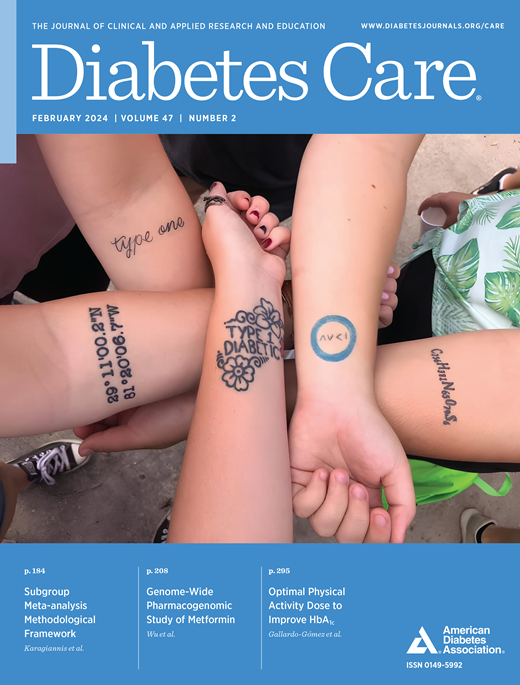A Multimodal Predictive Model for Chronic Kidney Disease and Its Association With Vascular Complications in Patients With Type 2 Diabetes: Model Development and Validation Study in South Korea and the U.K.
IF 16.6
1区 医学
Q1 ENDOCRINOLOGY & METABOLISM
引用次数: 0
Abstract
OBJECTIVE To develop a multimodal model to predict chronic kidney disease (CKD) in patients with type 2 diabetes mellitus (T2DM), given the limited research on this integrative approach. RESEARCH DESIGN AND METHODS We obtained multimodal data sets from Kyung Hee University Medical Center (n = 7,028; discovery cohort) for training and internal validation and UK Biobank (n = 1,544; validation cohort) for external validation. CKD was defined based on ICD-9 and ICD-10 codes and/or estimated glomerular filtration rate (eGFR) ≤60 mL/min/1.73 m2. We ensembled various deep learning models and interpreted their predictions using explainable artificial intelligence (AI) methods, including shapley additive explanations (SHAP) and gradient-weighted class activation mapping (Grad-CAM). Subsequently, we investigated the potential association between the model probability and vascular complications. RESULTS The multimodal model, which ensembles visual geometry group 16 and deep neural network, presented high performance in predicting CKD, with area under the receiver operating characteristic curve of 0.880 (95% CI, 0.806–0.954) in the discovery cohort and 0.722 in the validation cohort. SHAP and Grad-CAM highlighted key predictors, including eGFR and optic disc, respectively. The model probability was associated with an increased risk of macrovascular complications (tertile 1 [T1]: adjusted hazard ratio, 1.42 [95% CI, 1.06–1.90]; T2: 1.59 [1.17–2.16]; T3: 1.64 [1.20–2.26]) and microvascular complications (T3: 1.30 [1.02–1.67]). CONCLUSIONS Our multimodal AI model integrates fundus images and clinical data from binational cohorts to predict the risk of new-onset CKD within 5 years and associated vascular complications in patients with T2DM.2型糖尿病患者慢性肾脏疾病及其与血管并发症相关的多模式预测模型:韩国和英国的模型开发和验证研究
目的:考虑到对2型糖尿病(T2DM)患者慢性肾脏疾病(CKD)的综合研究有限,建立一种多模式预测模型。研究设计和方法我们获得了来自庆熙大学医学中心的多模态数据集(n = 7028;发现队列)用于培训和内部验证以及UK Biobank (n = 1,544;验证队列)进行外部验证。CKD的定义基于ICD-9和ICD-10编码和/或估计肾小球滤过率(eGFR)≤60 mL/min/1.73 m2。我们整合了各种深度学习模型,并使用可解释的人工智能(AI)方法解释了它们的预测,包括shapley加性解释(SHAP)和梯度加权类激活映射(Grad-CAM)。随后,我们研究了模型概率与血管并发症之间的潜在关联。结果结合视觉几何组16和深度神经网络的多模态模型预测CKD的效果较好,发现组的受试者工作特征曲线下面积为0.880 (95% CI, 0.806-0.954),验证组的受试者工作特征曲线下面积为0.722。SHAP和Grad-CAM分别强调了关键的预测因子,包括eGFR和视盘。模型概率与大血管并发症的风险增加相关(指标1 [T1]:校正风险比为1.42 [95% CI, 1.06-1.90];T2: 1.59 [1.17-2.16];T3: 1.64[1.20-2.26])和微血管并发症(T3: 1.30[1.02-1.67])。结论:我们的多模态AI模型整合了来自两国队列的眼底图像和临床数据,用于预测T2DM患者5年内新发CKD的风险和相关血管并发症。
本文章由计算机程序翻译,如有差异,请以英文原文为准。
求助全文
约1分钟内获得全文
求助全文
来源期刊

Diabetes Care
医学-内分泌学与代谢
CiteScore
27.80
自引率
4.90%
发文量
449
审稿时长
1 months
期刊介绍:
The journal's overarching mission can be captured by the simple word "Care," reflecting its commitment to enhancing patient well-being. Diabetes Care aims to support better patient care by addressing the comprehensive needs of healthcare professionals dedicated to managing diabetes.
Diabetes Care serves as a valuable resource for healthcare practitioners, aiming to advance knowledge, foster research, and improve diabetes management. The journal publishes original research across various categories, including Clinical Care, Education, Nutrition, Psychosocial Research, Epidemiology, Health Services Research, Emerging Treatments and Technologies, Pathophysiology, Complications, and Cardiovascular and Metabolic Risk. Additionally, Diabetes Care features ADA statements, consensus reports, review articles, letters to the editor, and health/medical news, appealing to a diverse audience of physicians, researchers, psychologists, educators, and other healthcare professionals.
 求助内容:
求助内容: 应助结果提醒方式:
应助结果提醒方式:


